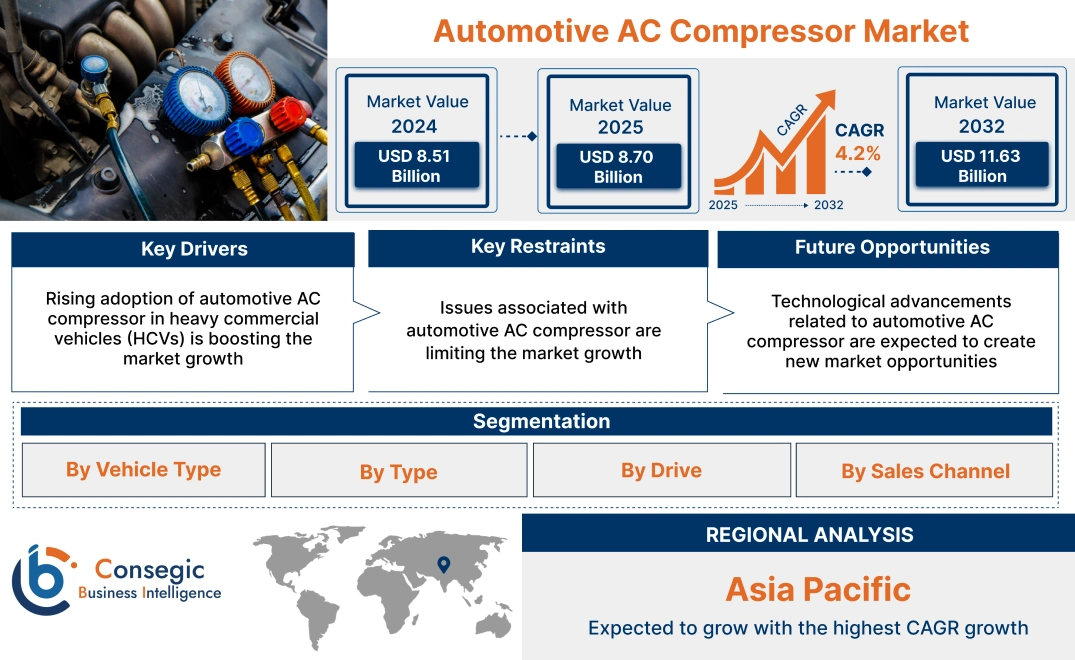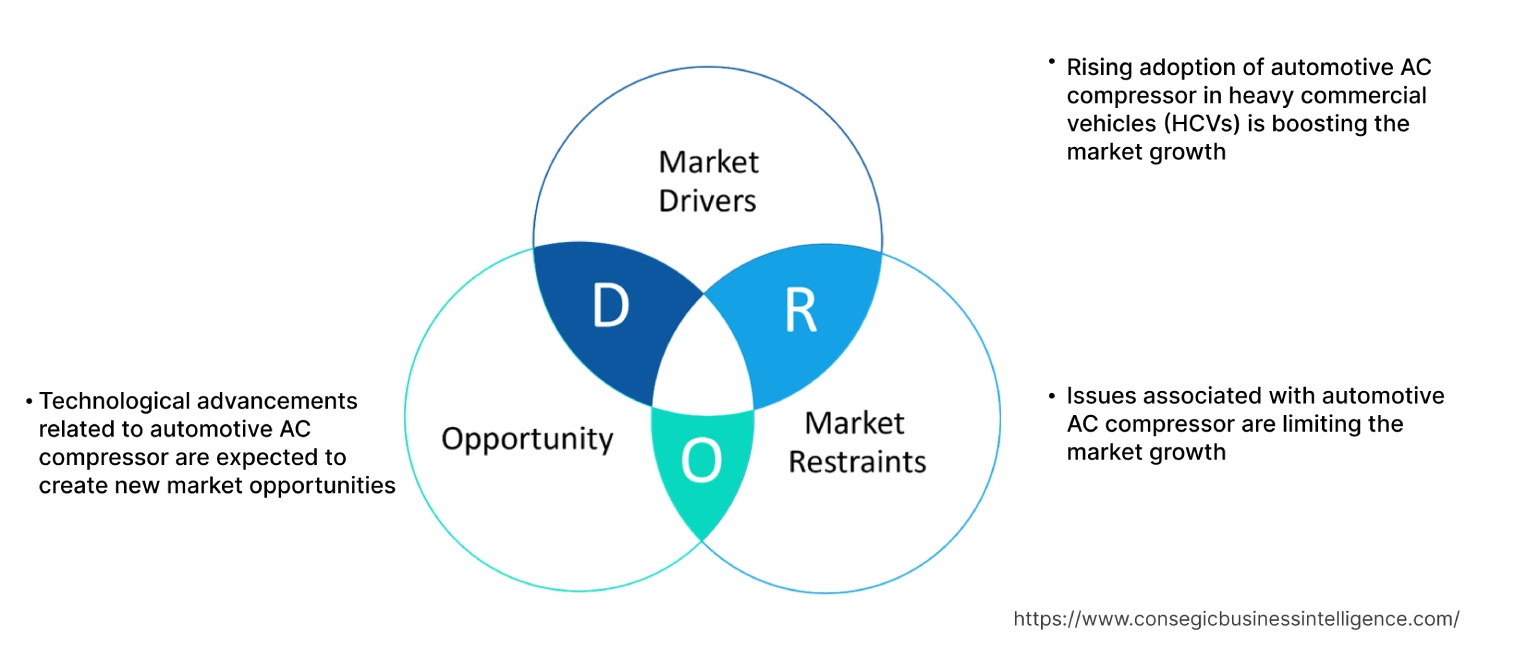- Summary
- Table Of Content
- Methodology
Automotive AC Compressor Market Size:
Automotive AC Compressor Market size is estimated to reach over USD 11.63 Billion by 2032 from a value of USD 8.51 Billion in 2024 and is projected to grow by USD 8.70 Billion in 2025, growing at a CAGR of 4.2% from 2025 to 2032.
Automotive AC Compressor Market Scope & Overview:
Automotive AC compressors are used to compress the refrigerant gas, increasing its pressure and temperature. This pressurized refrigerant then enters the condenser. By compressing and circulating the refrigerant, the compressor initiates the heat transfer process, effectively removing heat from the vehicle's interior and making it cooler. The AC compressor ensures a comfortable cabin temperature, particularly in warmer climates, by controlling the temperature and humidity of the air flowing into the vehicle's interior. The compressor regulates the pressure of the refrigerant within the system, ensuring proper cooling performance.
Key Drivers:
Rising adoption of automotive AC compressor in heavy commercial vehicles (HCVs) is boosting the market growth
The AC compressors are used in HCVs due to various benefits provided by compressors including driver comfort and productivity, enhanced safety, better visibility, and alertness. Moreover, reduced fatigue and improved alertness lead to faster reaction times and better decision-making, contributing to safer driving that is crucial for heavy commercial vehicles drivers. AC compressor helps maintain clear visibility by defogging and de-icing windows, offering safe navigation and preventing accidents. AC compressors are designed for durability and reliability, even in the demanding conditions of heavy commercial vehicles.
- For instance, in September 2022, TCCI launched 850V electric compressor for heavy commercial vehicles. The compressor is available in 34cc, 46cc, 60cc, and 120cc, providing optimal cabin and battery cooling.
Thus, the aforementioned factors are boosting the adoption of AC compressor in HCVs, in turn, driving the automotive AC compressor market growth.
Key Restraints:
Issues associated with automotive AC compressor are limiting the market growth
AC systems require additional energy from the engine, which leads to reduced fuel efficiency particularly in belt-driven AC compressors. AC compressors experience wear and tear due to continuous operation and require regular maintenance or replacement, adding to the operational costs. Moreover, use of refrigerants including R-134a contribute to global warming and ozone depletion.
Furthermore, improper maintenance or refrigerant leaks can lead to health issues and fatal accidents. Additionally, poorly maintained compressors generate excessive noise leading to inconvenience and poor driving experience. Thus, the market analysis shows that the aforementioned factors are restraining the automotive AC compressor market demand.
Future Opportunities :
Technological advancements related to automotive AC compressor are expected to create new market opportunities
Automotive AC compressors are experiencing steady technological advancements, leading to enhanced fuel efficiency, reduced fuel consumption, increased customer satisfaction, and lowered costs. Innovations including oil free compressor designs enables reduced maintenance costs and enhanced purity of compressed air, leading to reduced contamination risks, thereby, requiring lesser maintenance or repairs. Furthermore, advancements in scroll compressors and electric compressors offer higher efficiency and reduced noise. The electric compressors are able to operate when the power engine is shut off, leading to enhanced fuel efficiency.
- For instance, in September 2023, Denso launched advanced vehicle cooling system for commercial vehicles. This system uses small electric compressor developed using in-vehicle technology. These systems showcased reduction of power consumption by 57%.
Thus, the ongoing advancements in AC compressors are projected to drive automotive AC compressor market opportunities during the forecast period.
Automotive AC Compressor Market Segmental Analysis :
By Vehicle Type:
Based on the vehicle type, the market is segmented into passenger cars, LCV, ad HCV.
Trends in the Vehicle Type:
- Rising adoption of electric AC compressors in HCVs for better environment performance, improved system controls, and reduced load on the engine.
- Increasing adoption of electric AC compressors in LCVs ((light commercial vehicles) for increased safety, reduced emissions, and increased vehicle performance.
The passenger cars segment accounted for the largest revenue share in the market in 2024.
- Automotive AC compressors in passenger cars compress refrigerant, increasing its temperature and pressure, which is essential for cooling the cabin.
- These compressors are crucial for maintaining a comfortable and safe driving environment, particularly in hot climates. Additionally, these compressors contribute to better fuel economy and vehicle longevity.
- For instance, MAHLE offers AC compressors for passenger cars along with other air conditioning components. These compressors are based on swash plate simple harmonic motion mechanism and offer variable displacement piston technology.
- Therefore, the wide spread adoption of passenger cars worldwide is boosting the automotive AC compressor market growth.
The LCV segment is expected to register the fastest CAGR during the forecast period.
- In LCVs, an AC compressor enables the AC system to regulate cabin temperature, remove humidity, and improve air quality, leading to increased comfort and reduced driver fatigue.
- For instance, Guchen offers DC powered air conditioning systems with electric brushless motor rotary compressors in a closed circuit for electric parking trucks. The compressor model is GYES25 and the set temperature varies from 15 to 32 degree Celsius.
- Thus, the market analysis shows that the rising demand for LCVs is expected to boost the automotive AC compressor market trends during the forecast period.
By Type:
Based on the type, the market is segmented into variable displacement, fixed displacement, and electric compressor.
Trends in the Type:
- Rising adoption of fixed displacement compressor for higher performance is boosting the market growth.
- Increasing adoption of electric compressor due to its improved efficiency, ability to operate when engine is off, and reduced engine load among others.
The variable displacement segment accounted for the largest revenue share of 61.88% in the market in 2024.
- The variable displacement compressors run at the necessary capacity that offers minimized energy waste and improved overall fuel economy.
- Moreover, continuous operation at a steady capacity reduces wear and tear on the compressor and other components as compared to the repeated stress of cycling on and off, in turn, extending the life of the system.
- For instance, Sanden Corporation offers variable displacement type compressors for conventional vehicles. These compressors are available in various types including swash plate and wobble plate type.
- Therefore, the market analysis depicts that the above benefits provided by variable displacement compressors are further driving its adoption, in turn boosting the automotive AC compressor market demand.
The electric compressor segment is expected to register the fastest CAGR during the forecast period.
- The electric compressor circulates the refrigerant in the system by using power of an electric motor that drives the piston inside the cylinder to compress the refrigerant.
- Electric compressors are efficient due to independent operation and the ability to control compressor speed, leading to lower energy consumption.
- For instance, Guchen offers electric car AC compressor in its product portfolio. The products are available in various models including GC20A320, GC27A320, and GC34A350.
- Thus, the rising adoption of electric vehicles is boosting the usage of electric compressor, which is expected to drive the automotive AC compressor market trends during the forecast period.
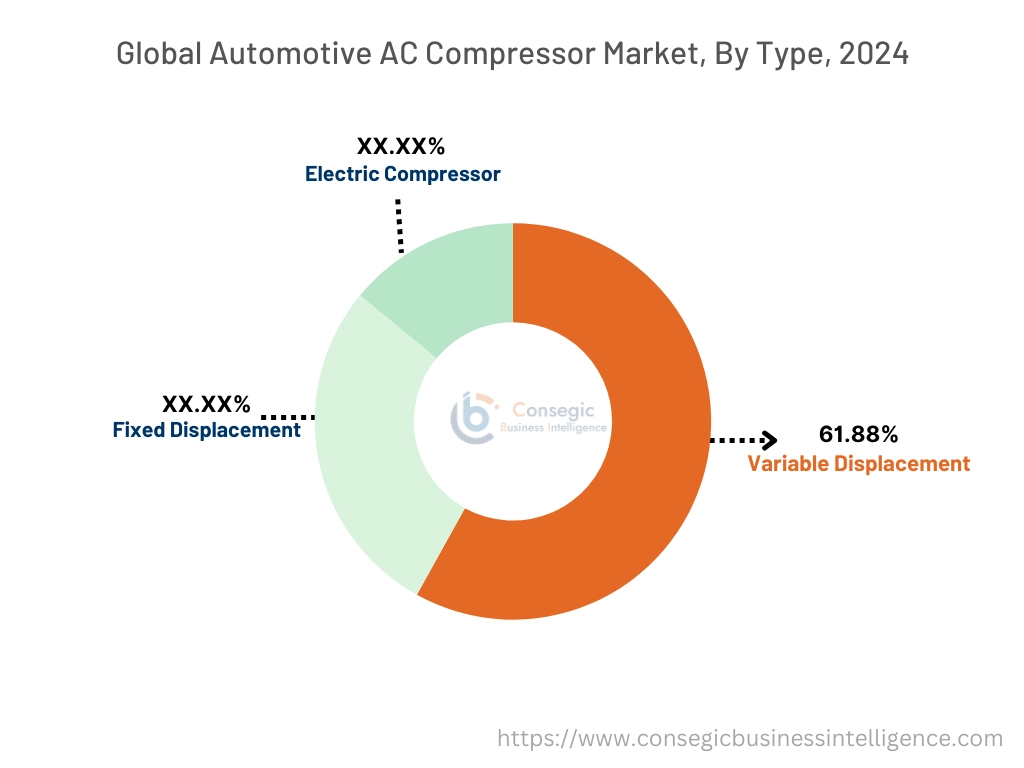
By Drive:
Based on the drive, the market is segmented into belt-driven and electric-driven.
Trends in the Drive:
- Rising demand for belt-driven AC compressors due to its several benefits including durability, longevity, and others.
- Increasing trend in adoption of electric-driven AC compressors, attributing to its reduced emissions and maintenance requirement.
The belt-driven segment accounted for the largest revenue share in the automotive AC compressor market share in 2024.
- Belt-driven AC compressors allow variable compressor speed and capacity based on engine load and temperature, which offers improved flexibility.
- These compressors also contribute to a smoother, quieter operation as compared to direct-drive systems and are cost effective.
- For instance, Standard Motor Products Inc. offers belt drive AC compressors in its product offerings. These compressors are available in 3 types including fixed displacement swashplate, variable displacement swashplate, and scroll, fixed or variable control.
- Therefore, the market analysis shows that the wide spread adoption of belt driven compressor for conventional cars is boosting the automotive AC compressor market size.
The electric-driven segment is expected to register the fastest CAGR during the forecast period.
- Electric-driven compressors offer improved fuel efficiency, reduced engine load, and enhanced vehicle performance.
- Moreover, these compressors also operate when the engine is off, providing consistent cooling in various driving conditions.
- For instance, Valeo offers electric-driven compressors for electric vehicles in its product portfolio. The compressors offer compact packaging and low weight with high performance and efficiency.
- Thus, the rising demand in electric vehicles is boosting the usage of electric-driven compressors, which is expected to boost the automotive AC compressor market opportunities during the forecast period.
By Sales Channel:
Based on the sales channel, the market is segmented into OEM and aftermarket.
Trends in the Sales Channel:
- Rising demand in aftermarket sales for customization at an affordable cost is boosting the market.
- Increasing adoption of OEM for high quality AC compressor for the production of vehicles is propelling the market.
The OEM segment accounted for the largest revenue in the automotive AC compressor market share in 2024.
- OEM (Original Equipment Manufacturer) offers high quality automotive parts that are directly used by automotive manufacturers in their automobiles.
- Moreover, OEM compressors are designed specifically for a vehicle model and are tested to ensure optimal performance and reliability.
- For instance, Delphi manufactures AC compressors for automotive industry. The compressors are available in various types including SP compressors, V5 and V7 compressors, compact variable compressors, and H6 compressors.
- Therefore, the market analysis depicts that the aforementioned factors are boosting the automotive AC compressor market size.
The aftermarket segment is expected to register the fastest CAGR during the forecast period.
- Aftermarket sales include repair, maintenance, or replacements of the AC compressors in automobiles due to damage or failure of the systems.
- Moreover, aftermarket solutions allow upgradation and customization of automotive systems while offering cost efficiency.
- For instance, MAHLE Aftermarket offers AC compressors in its aftermarket product portfolio. It offers maintenance, repair, and replacement solutions in case of failure or damage of AC compressor.
- Therefore, the wide benefits provided by aftermarket segment are expected to boost the automotive AC compressor market expansion during the forecast period.
Regional Analysis:
The regions covered are North America, Europe, Asia Pacific, the Middle East and Africa, and Latin America.
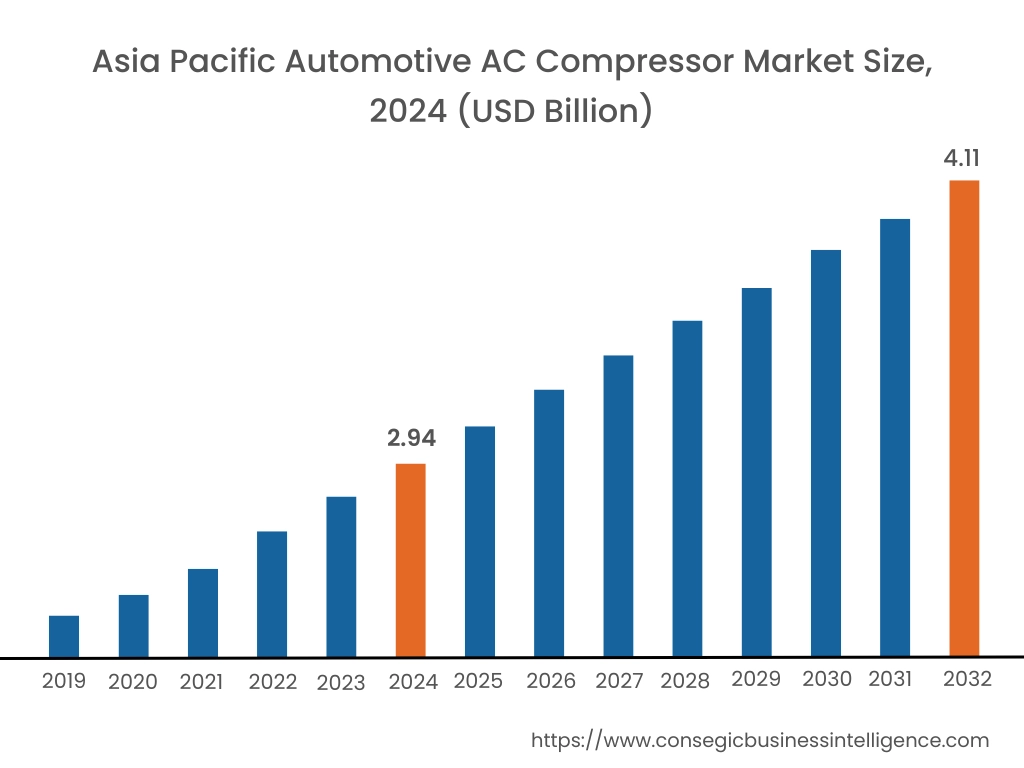
Asia Pacific region was valued at USD 2.94 Billion in 2024. Moreover, it is projected to grow by USD 3.01 Billion in 2025 and reach over USD 4.11 Billion by 2032. Out of this, China accounted for the maximum revenue share of 36.19%. The automotive AC compressor market analysis shows that the market in the Asia Pacific region is growing due to increasing trend in adoption of electric vehicles along with the well-established automotive manufacturing units. Countries including China, India, Japan, and South Korea are among the prominent automotive parts manufacturers in the world, leading to the market growth in Asia-Pacific region.
- For instance, Toyota, a Japan based AC compressor manufacturer, offers car AC compressors in its product portfolio. These compressors are available in various types including electric, continuous variable-displacement, and fixed-displacement. Therefore, the aforementioned factors are responsible for market growth in the Asia Pacific region.

North America is estimated to reach over USD 3.07 Billion by 2032 from a value of USD 2.23 Billion in 2024 and is projected to grow by USD 2.28 Billion in 2025. As per the automotive AC compressor market analysis in the North America region, the market is primarily driven due to well-established automotive industry that leads to aftermarket sales of AC compressors, in turn boosting the market growth.
- For instance, Standard Motor Products, a U.S-based manufacturer offers electric AC compressors in its product portfolio. The electric compressors are available in axial inverter and top inverter models. Thus, the market in the North American region is growing due to the aforementioned factors.
In Europe, the market is primarily due to rising infrastructural development that requires heavy commercial vehicles for transportation and construction purposes, in turn, leading to the automotive AC compressor market expansion. In Latin America, Middle East and Africa, the market is growing due to rising disposable income, leading to increasing adoption of passenger cars and light commercial vehicles, in turn, boosting the usage of AC compressors.
Top Key Players and Market Share Insights:
The automotive AC compressor industry is highly competitive with major players providing products and services to the national and international markets. Key players are adopting several strategies in research and development (R&D), product innovation, and end-user launches to hold a strong position in the global automotive AC compressor market. Key players in the automotive AC compressor industry include -
- Denso Corporation (Japan)
- MAHLE (Germany)
- Nissens (Denmark)
- Hanon Systems (South Korea)
- Aotecar New Energy Technology Co., Ltd (China)
- Automotive Thermal Systems Co., Ltd (China)
- Mitsubishi Heavy Industries (Japan)
- SANDEN (Japan)
- Standard Motor Product Inc. (US)
- Toyota Industries (Japan)
Automotive AC Compressor Market Ecosystem:
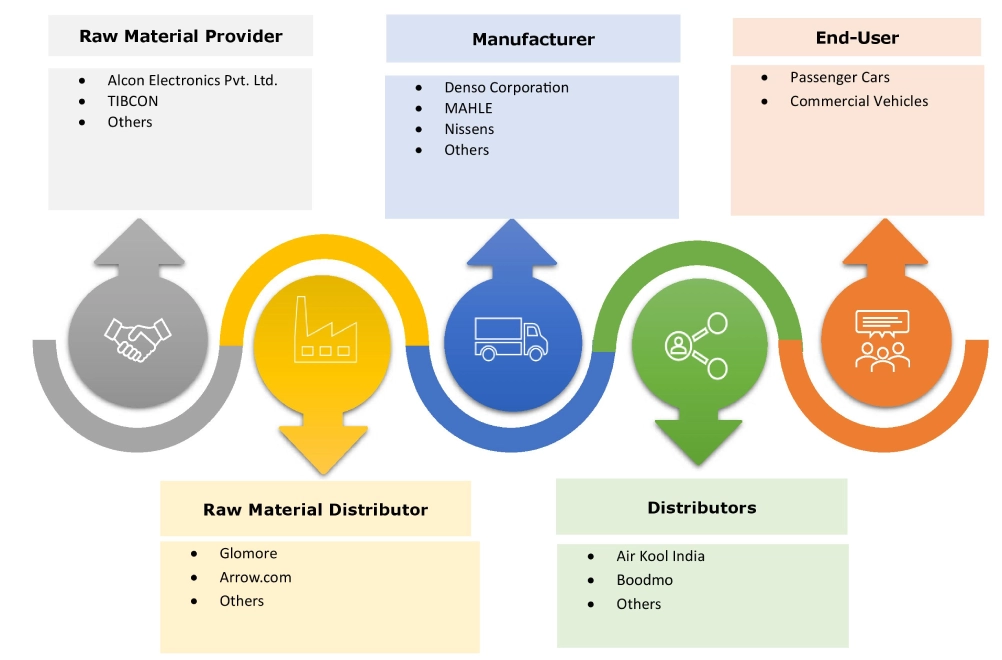
Automotive AC Compressor Market Report Insights :
| Report Attributes | Report Details |
| Study Timeline | 2019-2032 |
| Market Size in 2032 | USD 11.63 Billion |
| CAGR (2025-2032) | 4.2% |
| By Vehicle Type |
|
| By Type |
|
| By Drive |
|
| By Sales Channel |
|
| By Region |
|
| Key Players |
|
| North America | U.S. Canada Mexico |
| Europe | U.K. Germany France Spain Italy Russia Benelux Rest of Europe |
| APAC | China South Korea Japan India Australia ASEAN Rest of Asia-Pacific |
| Middle East and Africa | GCC Turkey South Africa Rest of MEA |
| LATAM | Brazil Argentina Chile Rest of LATAM |
| Report Coverage |
|
Key Questions Answered in the Report
How big is the automotive AC compressor market? +
Automotive AC Compressor Market size is estimated to reach over USD 11.63 Billion by 2032 from a value of USD 8.51 Billion in 2024 and is projected to grow by USD 8.70 Billion in 2025, growing at a CAGR of 4.2% from 2025 to 2032.
What are the major segments covered in the automotive AC compressor market report? +
The segments covered in the report are vehicle type, type, drive, sales channel, and region.
Which region holds the largest revenue share in 2024 in the automotive AC compressor market? +
Asia Pacific holds the largest revenue share in the automotive AC compressor market in 2024.
Who are the major key players in the automotive AC compressor market? +
The major key players in the market are Denso Corporation (Japan), MAHLE (Germany), Nissens (Denmark), Hanon Systems (South Korea), Aotecar New Energy Technology Co., Ltd (China), Automotive Thermal Systems Co., Ltd (China), Mitsubishi Heavy Industries (Japan), SANDEN (Japan), Standard Motor Product Inc. (US), Toyota Industries (Japan), and others.
